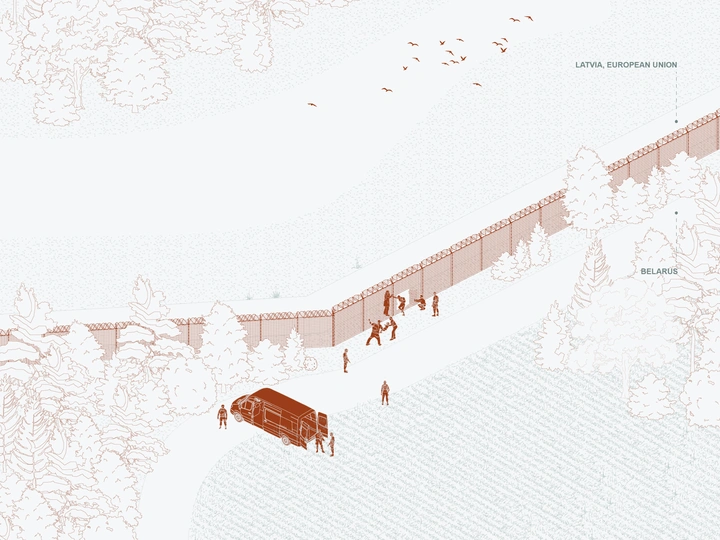Piedruja-Druja

Anna Grike
Danute Liva
Henk van Houtum
We are Darya Akhrameika and Danute Līva, an architectural research duo. While we each have independent practices, we collaborate specifically on the project focusing on the village Piedruja-Druja, a divided borderland between Latvia and Belarus. Through this collaboration, we combine our perspectives to explore complex social and political realities using spatial storytelling and immersive installations.
Darya Akhrameika (b. 1997 in Minsk, Belarus) is a spatial designer and architectural researcher, graduated from Minsk Colledge of Architecture and later from Gerrit Rietveld Academie (Amsterdam) in 2023. Working with illustartion, scenography, and immersive spatial installations, she often explores themes related to global politics and their impact on built environments. She often focuses on the context of Western-Eastern European relationships. Since 2023 Darya works as a part-time architectural designer in Polylester. In 2024 she started to work closely with dutch designer Richard Niessen on the public art commissions. Her autonomous works have been exhibited in the Netherlands, Belgium, Italy, Germany and Belarus.
Danute Līva (b. 1998, Riga, Latvia) graduated from the Gerrit Rietveld Academie’s Architectural Design Department in 2023. Her artistic research practice focuses on the representation of space and materials, with a particular interest in environments shaped by governmental decisions and large engineering projects. She investigates how these external factors influence communities, culture, and the environment. Since 2024, Danute has been part of Baltic Lines, an artistic research network studying the Rail Baltica mega-project. In addition to her artistic practice, she works as an editor for the spatial-criticism platform Failed Architecture.
In the framework of the Piedruja-Druja project we combine our backgrounds and perspectives—Danute’s experience in research and writing, and Darya’s expertise in spatial architecture and design.
Our project “Piedruja-Druja” is an architectural and spatial research-based investigation of the village divided by the border between Latvia and Belarus. The river that splits the village serves as a national and EU/NATO boundary, physically dividing a community once united during the Soviet era. We focus on how borders shape space, architecture, and everyday life, exploring themes like community division, borderland culture, the humanitarian crisis, and militarization.
The project began when we, a duo—Darya from Belarus and Danute from Latvia—accidentally discovered Piedruja-Druja village. The more we learned, the clearer it became that this village holds complex stories worth to be investigated and told about. Our research opened up layers beyond geopolitical division: the humanitarian crisis currently taking place at the Eastern EU border, restrictions on movement, and the increasing militarization profoundly affecting the physical and social landscape.
To develop the project, we conducted two on-site research trips to Piedruja-Druja, interviewing local residents and working extensively in archives and libraries. These methods helped us gather diverse perspectives and uncover the village’s rich, yet underrepresented, cultural history. We often think of borders as fixed lines where one thing ends and another begins, but our work shows them as complex spaces of both division and possibility—where new identities and stories emerge despite their role as powerful mechanisms of inclusion and exclusion.
Moving forward, the project is evolving into an immersive spatial installation, a series of essays and articles, and public lectures and workshops. We are collaborating with Dutch critical border cartographer Henk van Houtum and Latvian anthropologist Anna Griķe who is a board member of NGO “I want to help refugees”.